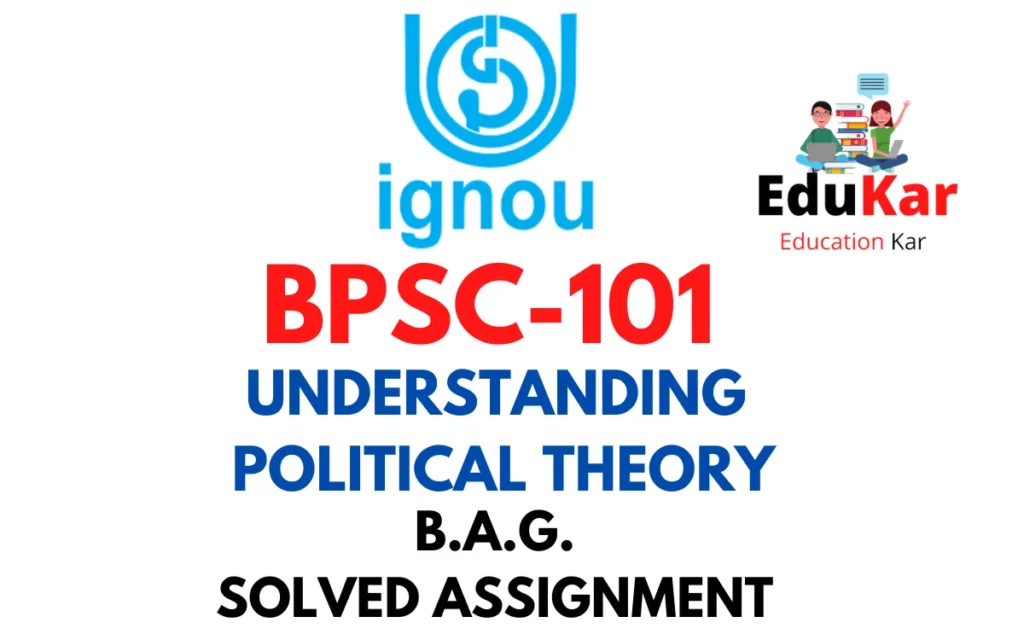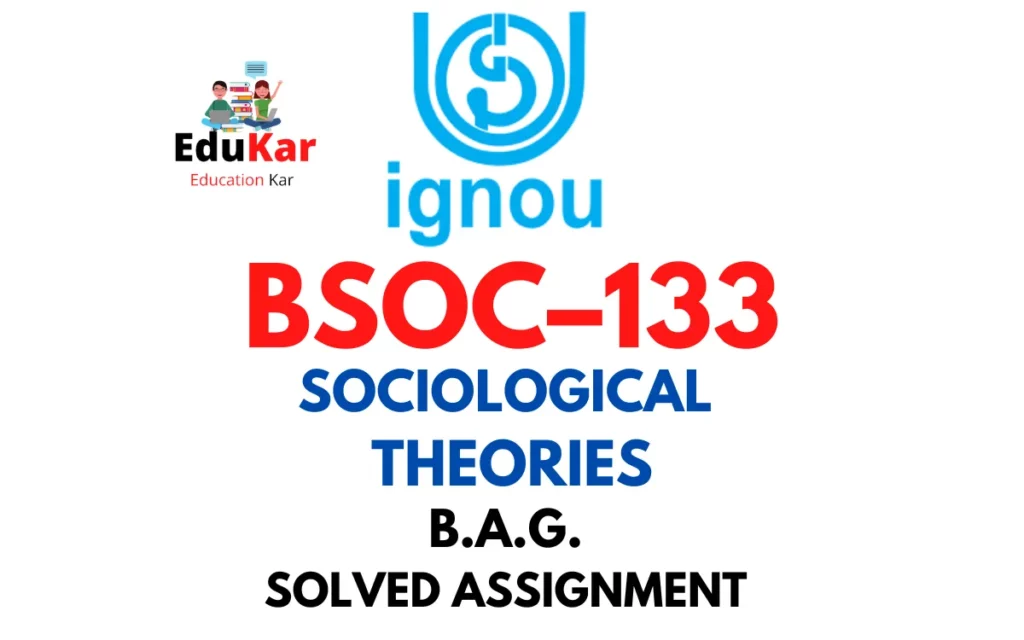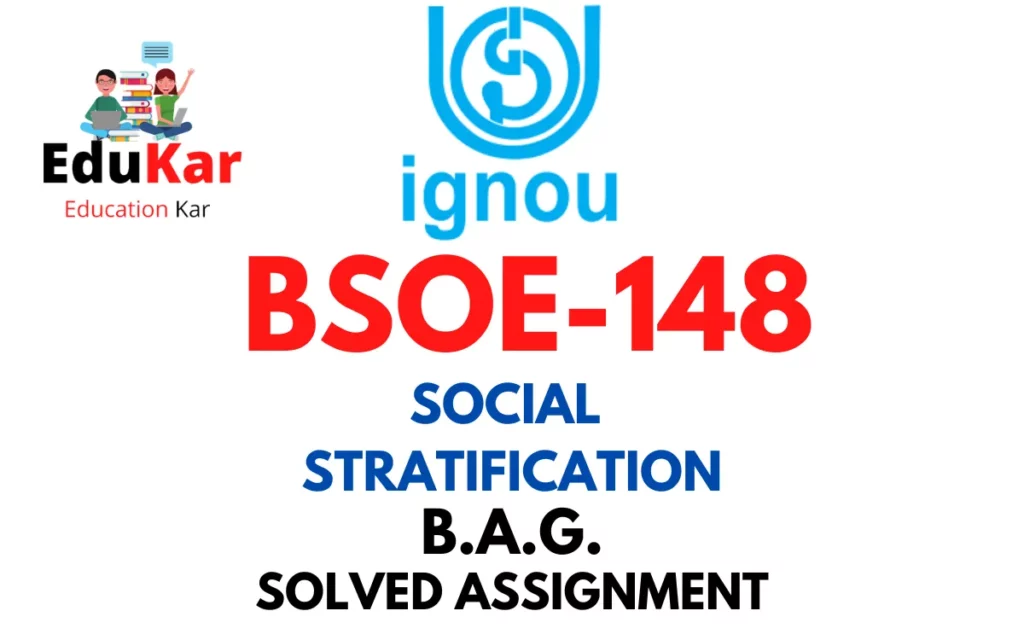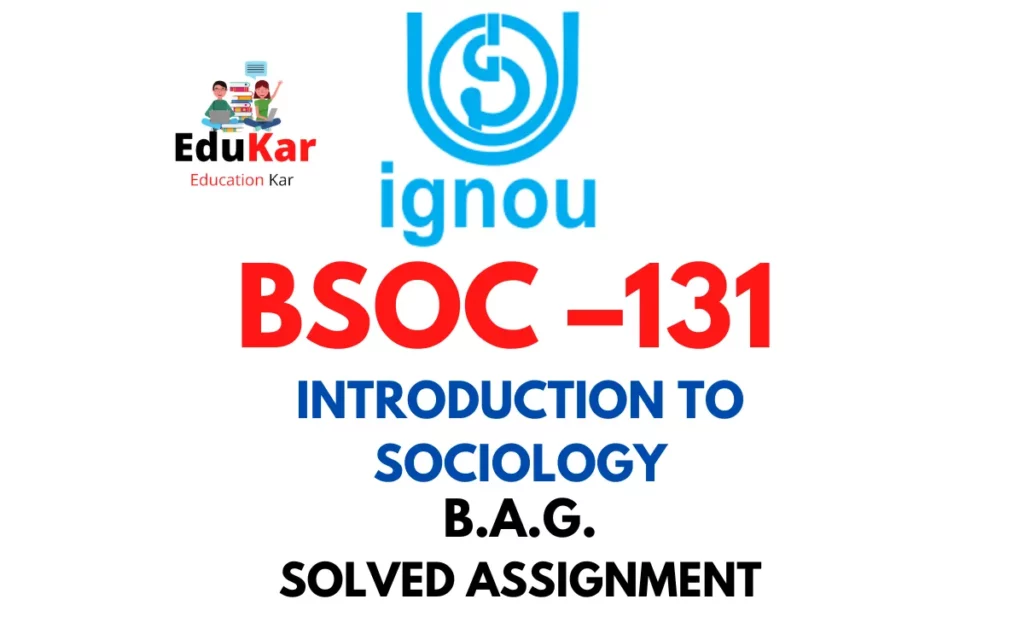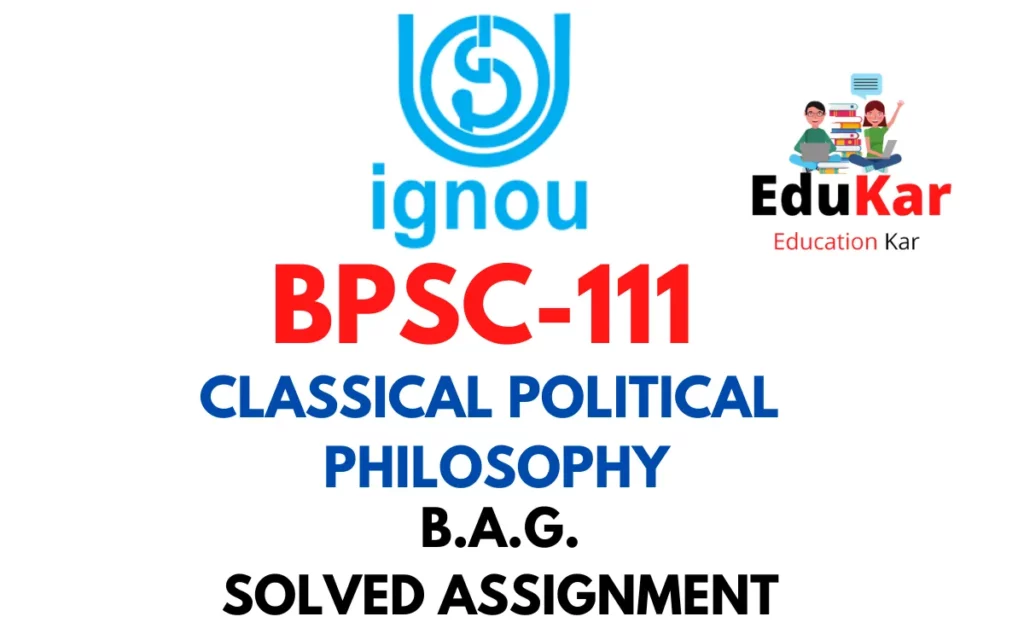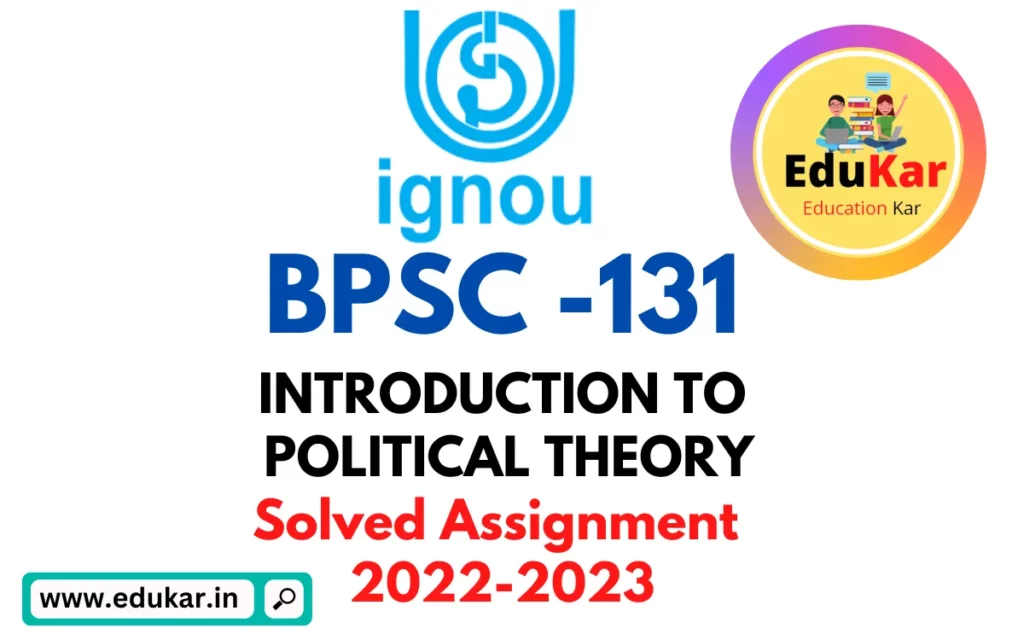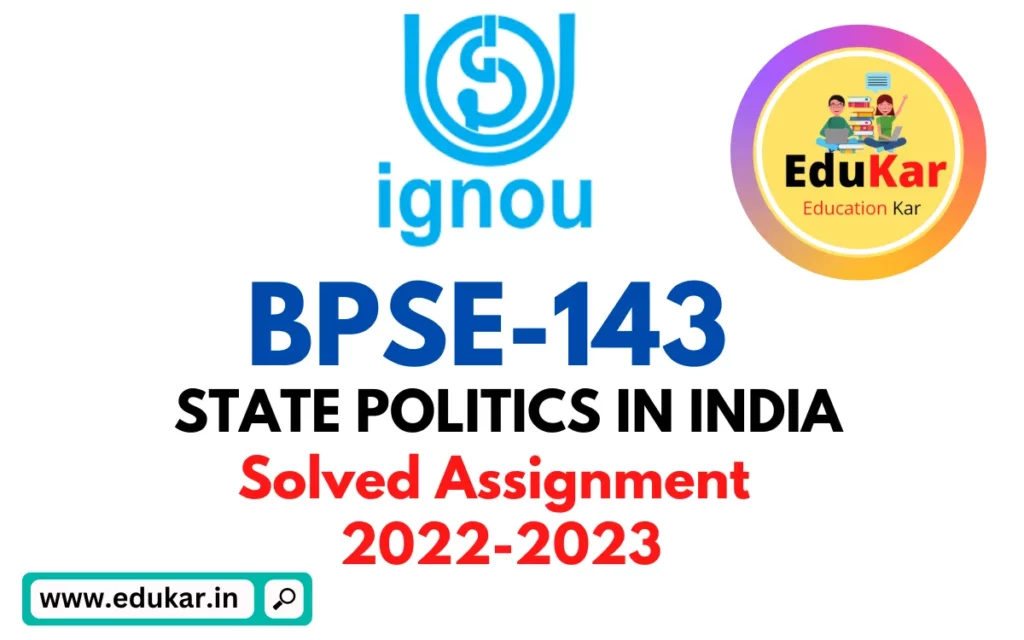Contents
- 1 Assignment – I
- 2 Answer the following in about 500 words each.
- 3 1. Discuss Marxist perspective to study Indian politics.
- 4 2. Explain the essential features of the Indian Constitution.
- 5 Assignment – II
- 6 Answer the following questions in about 250 words each.
- 7 3. Critically examine the Basic Structure doctrine.
- 8 4. Explain the powers and functions of the Speaker of Lok Sabha.
- 9 5. Discuss the parliamentary devices to control the executive.
- 10 Assignment – III
- 11 Answer the following questions in about 100 words each.
- 12 6. Write a brief note on Parliamentary Privileges.
- 13 7. Discuss the special powers and function of Rajya Sabha.
- 14 8. Explain the legislative powers of the President of India.
- 15 9. Write a note on the original jurisdiction of the Supreme Court.
- 16 10. Explain what is a Money Bill.

| Title | BPSC-132: IGNOU BAG Solved Assignment 2022-2023 (INDIAN GOVERNMENT AND POLITICS) |
| University | IGNOU |
| Degree | Bachelor Degree Programme |
| Course Code | BPSC-132 |
| Course Name | INDIAN GOVERNMENT AND POLITICS |
| Programme Name | Bachelor of Arts (General) |
| Programme Code | BAG |
| Total Marks | 100 |
| Year | 2022-2023 |
| Language | English |
| Assignment Code | BPSC-132/ASST/TMA/2022-23 |
| Last Date for Submission of Assignment: | For June Examination: 31st April For December Examination: 30th September |

Assignment – I
Answer the following in about 500 words each.
1. Discuss Marxist perspective to study Indian politics.
Ans: Marxism is a social, political, and economic theory originated by Karl Marx, which focuses on the struggle between capitalists and the working class. In the Marxist perspective, the state is seen as an instrument of the ruling class, which is used to maintain its dominance and oppress the working class.
In the context of Indian politics, Marxist perspective highlights the class struggle between the capitalist class and the working class in India. The capitalist class, which is represented by the big corporations and the rich landowners, exploits the working class by paying them low wages and depriving them of their basic rights. This leads to a widening gap between the rich and the poor, further perpetuating the capitalist system.
Marxists view the Indian state as a tool of the ruling class to maintain its dominance over the working class. The state is seen as having been established to protect the interests of the capitalist class and to ensure that the working class remains subservient. The Indian state is also seen as being influenced by global capitalism, which has led to the exploitation of the working class in India.
In India, the working class is represented by the peasants, workers, and the urban poor. They are seen as being oppressed by the capitalist class and the state, which uses its power to maintain its dominance over them. The working class in India is also seen as being exploited by multinational corporations, which exploit their labor and resources for profit.
The Marxist perspective in India also highlights the role of the Indian Communist Party, which has been instrumental in organizing the working class and fighting for their rights. The Communist Party has been at the forefront of the struggle against capitalism and imperialism in India, and has played an important role in the development of the Indian labor movement.
2. Explain the essential features of the Indian Constitution.
Ans: The Indian Constitution is the supreme law of India and lays down the framework for the country’s political system. It was adopted on 26th November 1949 and came into effect on 26th January 1950. The Indian Constitution has several essential features that make it one of the most comprehensive and complex constitutions in the world.
- Written Constitution: The Indian Constitution is a written constitution that lays down the framework for the country’s political and legal system. It comprises a preamble and 22 parts with 448 articles and 12 schedules. The Constitution is a living document that can be amended as and when required to meet the changing needs of society.
- Sovereign, Socialist, Secular, Democratic Republic: The Indian Constitution establishes India as a sovereign, socialist, secular, and democratic republic. This means that India is a sovereign nation, not subject to the control of any foreign power, and that it is committed to the principles of socialism and secularism. The country is also a democratic republic, where the people elect their representatives to govern them.
- Fundamental Rights: The Indian Constitution guarantees several fundamental rights to its citizens, including the right to equality, freedom of speech and expression, religion, assembly, and movement. These rights are considered essential for the development of a free and democratic society and cannot be taken away by the state.
- Directive Principles of State Policy: The Indian Constitution lays down the Directive Principles of State Policy, which are a set of guidelines for the government to follow in order to promote the welfare of the people. These principles include the promotion of education, protection of the environment, and the provision of social security for the economically weaker sections of society.
- Federal System of Government: The Indian Constitution establishes a federal system of government, where powers are divided between the central government and the state governments. This system of government allows for the decentralization of power and ensures that the needs of each state are addressed.
- Separation of Powers: The Indian Constitution provides for the separation of powers between the three branches of government – the legislature, the executive, and the judiciary. This system of checks and balances helps to prevent any one branch of government from becoming too powerful and ensures that the government operates within the limits of the Constitution.
- Independent Judiciary: The Indian Constitution establishes an independent judiciary, which is responsible for interpreting the Constitution and settling disputes between individuals and the state. The judiciary plays an important role in maintaining the rule of law and protecting the rights of the citizens.
- Quasi-Federal System: Although the Indian Constitution establishes a federal system of government, it also provides for the central government to exercise certain powers over the states in certain circumstances. This makes the Indian system a quasi-federal system, where the central government has some powers over the states but the states also have significant powers of their own.
Assignment – II
Answer the following questions in about 250 words each.
3. Critically examine the Basic Structure doctrine.
Ans: The Basic Structure doctrine is a principle in Indian constitutional law that holds that certain features of the Constitution are inviolable and cannot be altered or destroyed, even by amendment. This doctrine was established by the Supreme Court of India in the landmark case of Kesavananda Bharati v. State of Kerala in 1973.
Critics argue that the Basic Structure doctrine is too vague and gives the judiciary too much power over the legislative branch. They argue that the doctrine is not clearly defined, leaving it open to interpretation by the courts, which can lead to inconsistent decisions. Furthermore, they argue that the judiciary’s power to strike down amendments to the Constitution goes against the democratic principles of separation of powers and checks and balances.
However, supporters of the Basic Structure doctrine argue that it is necessary to protect the essential elements of the Constitution from being amended in ways that would undermine the fundamental rights and freedoms guaranteed to citizens. They argue that without the Basic Structure doctrine, the Constitution would be vulnerable to alteration by the legislative branch, which may not always act in the best interest of the citizens.
In addition, proponents of the doctrine argue that the judiciary is the guardian of the Constitution and is responsible for ensuring that the Constitution is interpreted and applied in a way that upholds its values and principles. They argue that the Basic Structure doctrine is an important tool for the judiciary to use in order to preserve the integrity of the Constitution.
Overall, the Basic Structure doctrine remains a highly debated topic in India and its impact on the Indian constitutional system is still being evaluated. While some view it as a necessary safeguard for the protection of fundamental rights and freedoms, others see it as a threat to the democratic process and the separation of powers.
4. Explain the powers and functions of the Speaker of Lok Sabha.
Ans: The Speaker of the Lok Sabha is the head of the lower house of the Parliament of India, and plays a crucial role in the functioning of the Indian democratic system. The Speaker is elected by the members of the Lok Sabha and is responsible for conducting the proceedings of the house, maintaining order and discipline, and ensuring that the rules and procedures of the house are followed.
One of the key powers and functions of the Speaker of the Lok Sabha is to preside over the debates and discussions in the house. The Speaker ensures that the members follow the rules of the house and ensures that the proceedings are conducted in an orderly and respectful manner. The Speaker also has the power to allow or disallow members to speak, and can intervene in the proceedings if necessary to restore order.
Another important function of the Speaker is to serve as the final authority on questions of parliamentary procedure and to interpret the rules and regulations of the Lok Sabha. The Speaker is also responsible for deciding the admissibility of motions and amendments and for making rulings on points of order.
The Speaker of the Lok Sabha also plays a key role in the legislative process. The Speaker certifies bills passed by the Lok Sabha and forwards them to the President of India for consideration and assent. The Speaker is also responsible for ensuring that the government is held accountable to the house and that the members are able to hold the government to account through question time, debates, and discussions.
In addition to these powers and functions, the Speaker of the Lok Sabha also serves as the representative of the house in its dealings with other branches of government and with foreign dignitaries. The Speaker is also responsible for maintaining the privileges and immunities of the members of the Lok Sabha, and for ensuring that they are able to perform their duties without fear of outside influence or interference.
5. Discuss the parliamentary devices to control the executive.
Ans: Parliamentary devices play a critical role in controlling the executive branch of government and ensuring accountability. The parliamentary devices used in many countries, including India, include the following:
- Question Hour: This is a time during parliamentary sessions where members of the legislative branch can ask questions of the executive branch. This provides an opportunity for members to ask the government about its policies, decisions, and actions, and to hold the executive accountable.
- Debates and Discussions: Parliament provides a forum for members to engage in debates and discussions on matters of public interest. This allows members to scrutinize the government’s policies, decisions, and actions and to hold the executive accountable.
- Motions of No Confidence: This is a motion passed by the legislative branch indicating that it has lost confidence in the government. If a motion of no confidence is passed, the government is required to resign or call for new elections.
- Adjournment Motions: This is a motion that allows members of the legislative branch to raise a specific matter of public concern and to demand a response from the government. Adjournment motions are often used to bring attention to issues that have been neglected or ignored by the government.
- Committee System: Parliament has a system of committees that play an important role in scrutinizing the actions of the government. Committees are composed of members of the legislative branch and are responsible for examining specific issues and making recommendations to the government.
- Budgetary Process: The budgetary process provides an opportunity for the legislative branch to scrutinize the government’s financial policies and decisions. The legislative branch can amend the government’s budget proposals and make recommendations for changes to spending and taxation policies.
These parliamentary devices are essential for ensuring that the executive is accountable to the legislative branch and to the citizens. They provide a means for members of the legislative branch to hold the government accountable for its actions, policies, and decisions, and to ensure that the executive is working in the best interest of the citizens.
Assignment – III
Answer the following questions in about 100 words each.
6. Write a brief note on Parliamentary Privileges.
Ans: Parliamentary privileges refer to the rights and immunities enjoyed by members of Parliament in order to carry out their duties and responsibilities effectively. These privileges include freedom of speech, immunity from legal proceedings for statements made in the Parliament, and the right to access government information. Parliamentary privileges are essential for the functioning of a democratic system, as they enable members of Parliament to freely debate and scrutinize the actions of the government without fear of retaliation. However, these privileges must be used responsibly and must not be abused in any way that undermines the principles of democracy.
7. Discuss the special powers and function of Rajya Sabha.
Ans: The Rajya Sabha, also known as the Council of States, is the upper house of the Indian Parliament. It has a special role in Indian politics as it represents the interests of the states and union territories of India. The Rajya Sabha has several special powers and functions that make it an important component of the Indian political system.
One of its key powers is the power to block legislation passed by the lower house, the Lok Sabha, by rejecting or delaying its passage. The Rajya Sabha also has the power to recommend changes to financial bills and has the power to delay the passage of non-financial bills for a maximum of six months.
The Rajya Sabha also plays a crucial role in the representation of the states in the national legislature and provides a platform for the discussion of national and international issues. It also serves as a forum for the representation of the interests of different communities and regions of India.
8. Explain the legislative powers of the President of India.
Ans: The President of India is the head of the executive branch of government, but also has some important legislative powers. The President has the power to summon and prorogue sessions of Parliament and to address both houses of Parliament. He also has the power to call special sessions of Parliament in exceptional circumstances.
The President has the power to assent to bills passed by Parliament, or to withhold assent if he feels that the bill is unconstitutional or against the public interest. The President can also return a bill to Parliament for reconsideration, or refer it to the Supreme Court for an opinion on its constitutionality.
The President also has the power to promulgate ordinances when Parliament is not in session. These ordinances have the same force and effect as a law passed by Parliament, but must be approved by Parliament within six weeks of its next session.
9. Write a note on the original jurisdiction of the Supreme Court.
Ans: The original jurisdiction of the Supreme Court of India refers to the power of the court to hear a case directly, without it first being heard by a lower court. This jurisdiction is exercised in cases involving disputes between states, between the central government and a state government, or between two or more states, and in cases involving disputes involving the interpretation of the Constitution. The Supreme Court’s original jurisdiction is a critical component of the Indian judicial system and provides a mechanism for resolving disputes between different levels of government and for interpreting the Constitution. This jurisdiction helps to maintain the balance of power between the different branches of government and to ensure that the Constitution is upheld and protected. The original jurisdiction of the Supreme Court serves as a safeguard against abuse of power by the government and helps to ensure the independence and impartiality of the judiciary.
10. Explain what is a Money Bill.
Ans: A Money Bill is a type of legislation in India that deals primarily with the government’s taxation and spending policies. Money Bills can only be introduced in the lower house of the Parliament, the Lok Sabha, and must be passed by a simple majority vote. The purpose of Money Bills is to provide a mechanism for the government to raise revenue and to allocate funds for its various programs and initiatives. Money Bills typically include provisions for tax laws, government spending, and the creation or modification of financial institutions. Once a Money Bill is passed by the Lok Sabha, it is sent to the upper house, the Rajya Sabha, for review and approval, but the Rajya Sabha does not have the power to reject or amend a Money Bill. The power to pass Money Bills is a key tool for the government to control its fiscal policies and to ensure that it has the resources to carry out its responsibilities.
How to Download BPSC-132 Solved Assignment?
You can download it from the www.edukar.in, they have a big database for all the IGNOU solved assignments.
Is the BPSC-132 Solved Assignment Free?
Yes this is absolutely free to download the solved assignment from www.edukar.in
What is the last submission date for BPSC-132 Assignment?
For June Examination: 31st April, For December Examination: 30th October


